India’s best driver’s cars 2016
Autocar India’s Track Day fiesta brings together the best driver’s cars launched this year, India’s fastest driver and the best track for testing road cars.
Published On Sep 13, 2016 07:00:00 AM
55,025 Views
Follow us on



Autocar India’s annual track test generally goes by in a blur. The proceedings commence at the crack of dawn, and the photography doesn’t stop until late into the evening. And day 2 is just as manic.
No one, however, grudges the oil, sweat and gears; our track day has to be one of the most enjoyable events of the year. It appeals to us on a number of levels. On one hand there’s the sheer joy of seeing the cars we’ve invited being pushed to their limits against the clock; no quarter given, every ounce of speed extracted. And then you have the little private bets we place on our favourites: Which will come out on top? What time will they do? Taking an educated guess is an absolute blast.
Then there’s the analytical side of things, which is equally fascinating. Why is car A quicker than car B, and where exactly does it score an advantage? Understanding and explaining what makes a car drive the way it does is an important part of what we do after all. And the best part is that there’s no hiding on a track. If a car has a weakness, or a flaw, it’s bound to show up here.
Yes, on-track performance is quite different from real-world ability. And truth be told, the race track really is something of an alien environment for everyday road cars, especially those reconfigured to deliver fantastic fuel economy and ride well on our poorly surfaced roads. Still, if you are looking for a consistent measure of just how good a car is to drive and how fast it is against the clock – other things being equal – a good track is probably the best you can get.
This is why we’ve been conducting our annual track day around the Sriperumbudur race track, on the outskirts of Chennai, since 2008. What makes the Chennai track well suited to road cars is the fact that the layout prioritises grip, agility and balance over outright power and raw straight-line speed.
This year for the first time, the track was completely resurfaced. It was no doubt smoother and didn’t chew up tyres like before, but last year’s times or even all the years since we first started our track day couldn’t be used as reference. To get an idea if the track was slower or faster, we brought along an Audi TT – which we used last year – as a ‘control’ or reference car. The lap times were largely similar to last year’s, but since the tarmac was still fresh, grip levels were still patchy and inconsistent which made extracting the best times a bit more difficult, and some cars could have been a slightly quicker.
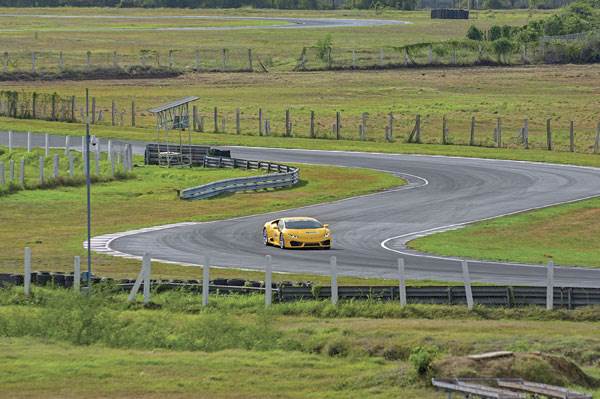
What has also given us tremendous consistency is the fact that all our track tests, every single timed lap, has been driven by none other than ex-Formula 1 and current Japanese Super Formula driver Narain Karthikeyan who, like every other year, was on the ball from the word go. His approach and methodology are quite unique. He takes only a half a lap to suss out the cars, most of them he’s never driven before. Where to brake, where to turn in, where to add throttle and where to allow the car to slide a bit wide – he figures out in that half-lap. Then, before you know it, it’s one ‘banzai’ lap where he grabs the car by the scruff of the neck and hurls it around like a rag doll. The violence and aggression on his first proper lap in the car are simply stupefying. How does he keep it on the black stuff? How are his lines so perfect that the traces we get on our VBox overlap each other? Then follow a couple of cool-down laps, after which he has another go where he applies what he’s learnt from the previous lap. We do occasionally go out for a third lap, if there’s been a mistake or if he thinks there’s a bit more potential to be extracted. But, generally, two laps are all we do before it’s time for the next car. Incredible.
So what are the best driver’s cars launched this year, and which are the fastest? Let’s get straight to it.
MARUTI BALENO 1.2 K12
2m20.17s
Track rating 5/10
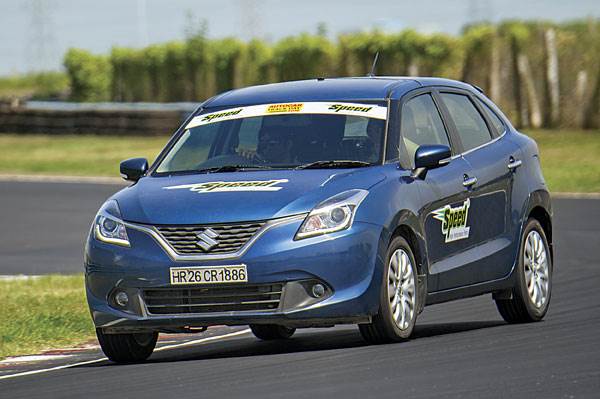
"In the dynamics department, it’s not as sharp as the Swift."
The Baleno’s 1.2 petrol engine is tuned so sweetly, it seems like it makes at least ten horsepower more than when under the hood of other Marutis. Narain was impressed. “The engine is punchy and because it is 90-odd kilograms lighter than the Swift, it feels quicker in a straight line. You can even carry a lot of speed into corners.” The Baleno, however, loses out because it understeers relatively early, and what makes it worse is that there is absolutely no feedback from the overly quick steering. So, in terms of the driving dynamics, Narain found it to be “no match for the Swift”, which he thought was “a bit of a let-down.”
FORD FIGO 1.5 TDCI
2m19.89s
Track rating 8/10
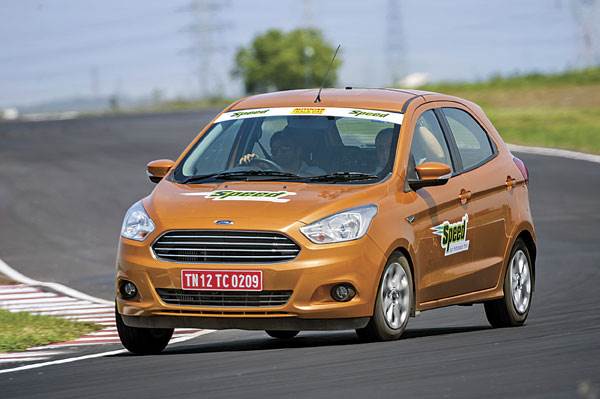
"Another excellent driver’s car from Ford; still needs a 152hp EcoBoost though."
On the face of it, Ford’s diesel Figo doesn’t seem to be a car well suited to the track. It has a heavy engine in its nose, generous ground clearance and then, it’s a diesel. But the 100hp Figo set a quicker time than even the Baleno, a car considered sporty by many. “It’s a lot of fun to drive, says Narain. It’s got a very strong front end, and a fair amount of oversteer and this means if you are neat, it points nicely into corners. The brakes are a bit grabby, but if you compare it to, say a Baleno, it’s in another league. Even the engine revs nicely all the way to the 5,000rpm redline.” And just look at that top speed with all the torque; it’s only 3kph shy of the Abarth!
FIAT ABARTH PUNTO
2m16.96s
Track rating 6/10
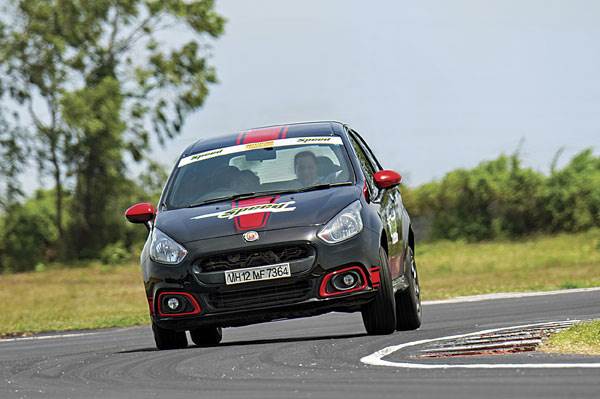
"Brilliant engine, but the suspension is too comfort oriented to be a real Abarth."
The Abarth Punto’s strong mid-range and considerable punch make it tremendous fun to drive in a straight line. And there’s plenty of feel from the steering. But this isn’t a car that’s well suited to hard cornering on the track, and that’s primarily down to the soft suspension: it just doesn’t let you carry speed into corners. “It gets full marks for a half-baked job,” says a clearly disappointed Narain. “The engine is phenomenal and the interior gives you a feel of the real thing, but the soft suspension just lets it down. It rolls so much, often you just can’t put the power down.” It should have at least been quicker than the Polo GT.
JAGUAR XE 25T PORTFOLIO
2m08.48s
Track rating 6/10
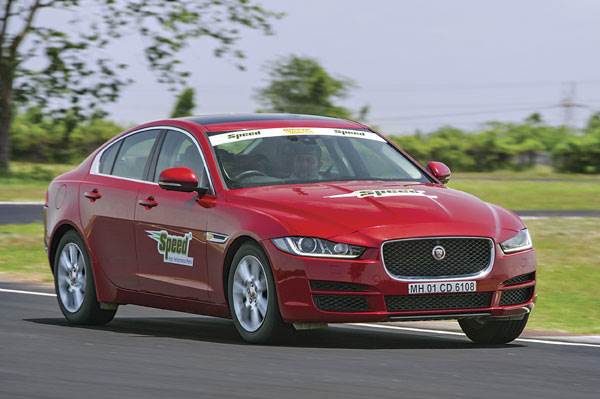
"It has a strong engine, but needs a stiffer suspension."
The XE’s got a strong 240hp engine and is a proper rear-wheel-drive chassis, so it promises much. It’s very quick and therefore fun in a straight line. Unfortunately, the car has been raised for India, the suspension has been softened for our roads and the tyres that have been chosen have a very high profile as well. So there’s plenty of body roll, and traction at the rear isn’t very good. This makes it extremely difficult to put all the power down on the track. Even Narain wasn’t comfy accelerating out of corners at full throttle. “There’s no limited slip differential and it tends to go into a tank-slapper, sliding one way and then the other, when you try and up the pace.” So it really isn’t fun.
AUDI S5 SPORTBACK
2m05.93s
Track rating 7/10
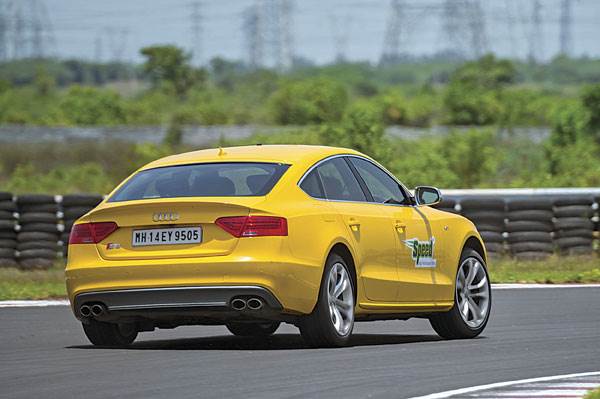
"Fast and effective, but handling is quite dull."
The Audi S5 has a super strong 333hp engine that pulls like a train in the mid-range. This allows it to get up to almost 170kph on the back straight; that’s extremely quick for a car this heavy. It carries a fair bit of speed into corners too. Its 122.2kph at the exit of C1 for example, is much higher than that of the Jaguar at 117.8kph, and the exit at C6 is also 10kph quicker than the Jag. Narain, however, wasn’t too impressed with how the quattro system transferred power. “The moment the rear wheels start sliding, the system sends a lot of power to the front, and then it understeers. After that, you have to back off on the gas to get back into the line, and that way, you lose a lot of time.”
PORSCHE MACAN TURBO
2m05.74s
Track rating 7/10
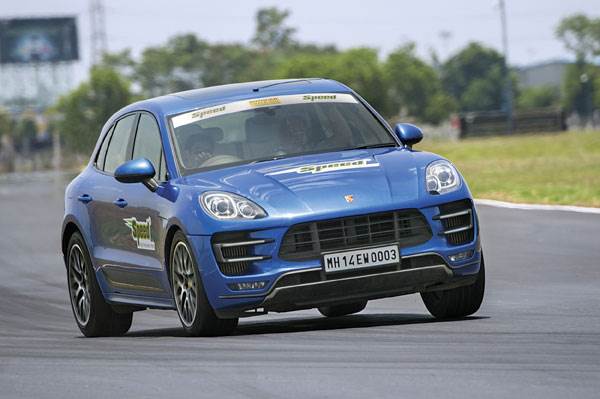
"Nice blend of SUV clearance and sporty dynamics."
The Porsche Macan Turbo promised a lot and, truth be told, it delivered too. Let’s not forget that this is an SUV that actually manages quite well off-road. And this isn’t any specially warmed-up version either. On the track the body control is quite good and roll is nicely limited. This allows it to howl through even some tight corners at a fair lick; see the speed it can carry for example at C1 exit and C2 apex. All that mass though does make its presence felt on the long C6, where it is only a bit faster than the Jaguar. Still, it could have been faster as the engine, at times, didn’t rev as enthusiastically as we would have liked it to, and this affected the lap times.
MERCEDES-AMG C 63 S
1m59.08s
Track rating 7/10
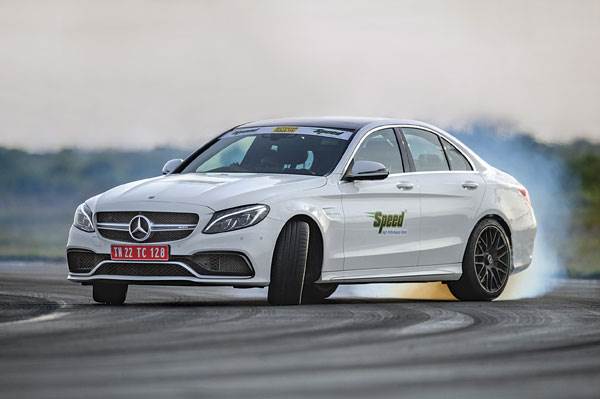
"Incredible engine, but it doesn’t have the grip to exploit it."
The C 63 S has a 510hp engine; no joking matter for a sedan of this size. And as a result, the Merc does a supercar-like 187kph down the back straight. Strange thing, however, is that BMW’s less potent 431hp M4 manages this too. This is because the AMG’s much softer suspension and less capable rear axle make it extremely difficult to put the power down cleanly. “Switch everything off and you just can’t put all the power down. And, the car is heavy and the brakes aren’t the best either,” Narain explains. The M4 for example is a huge 9kph and 11kph faster at C1 and C2 in comparison. And because they’ve built a lot of understeer in, for safety, the Merc first understeers and then oversteers, losing time again.
AUDI R8 V10 PLUS
1m54.46s
Track rating 8/10

"It’s a fantastic supercar, but the fail-safe handling is not ideal for the track."
The R8 has an incredible V10 that revs to 8,500rpm. This is central to the supercar experience, and the low-slung car feels perfectly at home around the track. “The incredible grip of the quattro system allows you to exploit a lot of the power, and the poise and confidence of the car make it relatively easy to put the power down too”. Audi, however, has built a bit too much safety into the new R8 for the track. “There’s plenty of understeer once the grip starts to fade and that means you have to back off (such as in C2),which is why it wasn’t quicker. But otherwise the car feels fantastic on the track. What a strong engine, and the transmission is just fantastic.”
LAMBORGHINI HURACÁN LP580-2
1m53.21s
Track rating 9/10
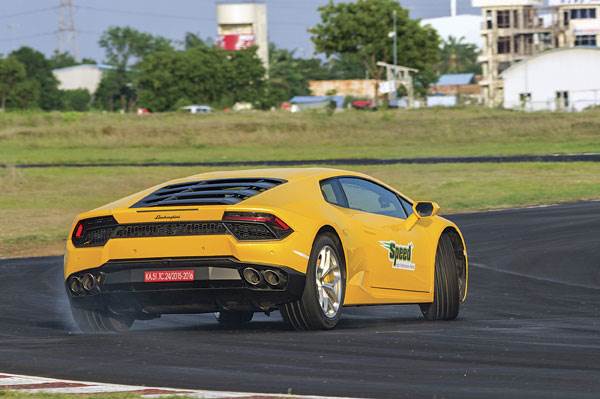
"The quintessential Italian supercar; but not for novices."
Lamborghini was roundly criticised for making the four-wheel-drive Huracán too easy to drive and a bit blunt. But now it’s back with the much-sharper driving, rear-wheel-drive 580-2. It has the healthiest power-to-weight ratio here (a massive 397hp per tonne), and the 197.94kph top speed tells you in no uncertain terms that it can go like a missile. What also makes a big difference is that the suspension is stiffer than the R8’s. “So it can go from mid-corner to the next a bit faster. And that’s where it gains a bit of speed,” says Narain.
“But this is also a handful with the ESP off. Novice drivers need to respect it and keep the driver aids on; otherwise with the weight of the V10 swinging in the back and its ability to spin its wheels all the way past 160kph, it’s quite easy to wrap around a tree.”
Guest Appearance
PORSCHE 911 GT3
1m50.39s
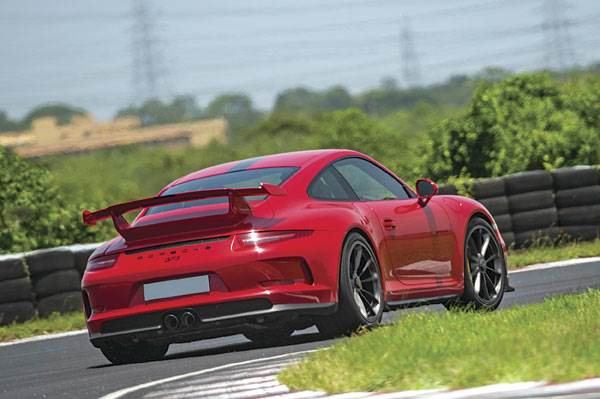
Say a big hello to this year’s wild-card entry, the 911 GT3 – the big daddy of track day cars. The rear-drive GT3 wasn’t an official entry, but it still blitzed our lap record. And that’s despite only having 475hp; a far cry from the current holder, the Turbo S that has 580hp. Many of us didn’t think it could do it, but that’s because we had forgotten about all the extra grip from the track-tuned chassis, the race car-like suspension and its ability to change directions like a peregrine falcon. It hit 200 at the end of the straight, and was a full 5kph faster exiting C1 than the Turbo S and 6kph faster getting onto the start/finish straight. Narain was in raptures, “Even on the track, it feels hard-edged, and it throws you around, and gives you a feeling of a proper race car. The weight transfer and the manner in which it builds grip and slides are just perfect and this is reflected in the time it has done.” Who needs turbo or four-wheel drive?
Behind the scenes
We follow the same procedure for each and every timed lap. Narain gets in to the car, adjusts his driving position and gets comfortable. He then looks for the traction control and electronic stability. Everything has to be off. This, at times, is more difficult than it seems, because many cars today have a two-stage ESP that allows the system to cut in after a certain angle has been achieved. While this is going on, we on the other side of the car plug in our VBox – the aerial, the wires, the trigger and the display. The video team gets busy too, festooning the car with, at times, half a dozen GoPros. Once we are ready, we call the tower on the walkie and set off. Then follows some of the hardest driving the car in question is ever likely to endure. After the laps are done, we come into the pits for a download of data from the VBox and reactions from Narain. Data checked, laps loaded on our laptops and video bytes taken from Narain, we move to the next car. Any extra photography is kept for either early morning or late evening.
Also read:
Copyright (c) Autocar India. All rights reserved.



Comments
Member Login
Personal Details
No comments yet. Be the first to comment.